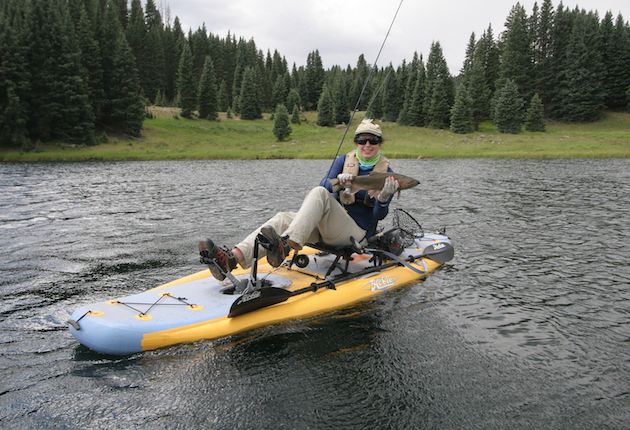Our checklists had been scrutinized and rechecked. Our expedition bags were packed with fishing apparel and waders for daytime use and dress clothes for the evenings. The metal fly rod tubes seemed to wait impatiently by the door, alongside carry-on bags packed with cameras, laptops, and, of course, my lucky fishing hat. All we had to do now was get there.
People often say there’s no place like home, but some of my most cherished memories come from destination trips and time spent with family. And so my husband, parents, and I were off for a week at The Lodge and Ranch at Chama Land & Cattle Company in northern New Mexico’s soaring San Juan Mountains, a 36,000-acre ranch recognized worldwide for its premier elk hunting, five-star accommodations, and pristine high-country trout lakes and streams. There we would partner with some of the most highly respected names in the fly fishing universe.
I’d like to share with you our firsthand experiences with the gear we used on this once-in-a-lifetime adventure. First, we will focus on the kayaks used on the lakes and the world-class rods that we carried cross-country and back again. In the next story, we will discuss the apparel, felt-soled boots, and waders that combined versatility and portability to tackle these challenging fly fishing environments.
Kayaks: Hobie MirageDrive 180s
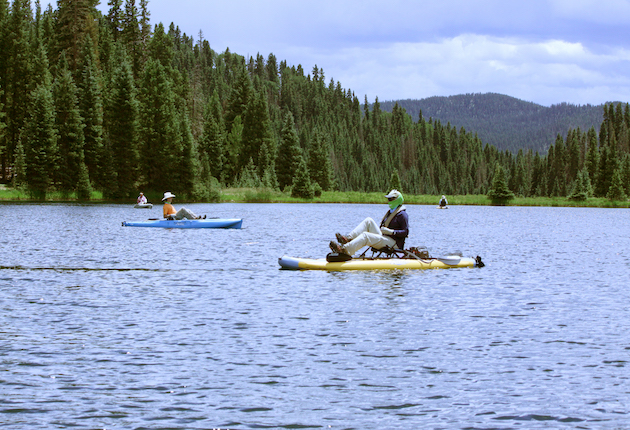
Out and about on the new Hobies on one of Chama’s high-country lakes.
“Carly, why are you pedaling backwards?”
Mere weeks ago, I never would have guessed that kayaking backwards would become an integral part of my fly fishing strategy while at Chama, where we teamed up with Hobie Cat Company to use their foot-powered MirageDrive kayaks on the high-country lakes. While I frequently fish from my own Hobie Mirage Outback back home in Tennessee, its MirageDrive foot pedals only propel the kayak forward. But Hobie Cat Company unveiled its new MirageDrive 180 with full-power reverse barely a week before our trip, and I jumped at the chance to field test this new feature on the inflatable Hobie Mirage i11s and Mirage Outback.
Due to the unusually warm summer, the big Chama trout were holding in deep water in the 10,000-foot mountain lakes, forcing us to troll with full sinking fly lines and a variety of weighted Woolly Buggers and streamers. I began trolling in the Hobie by pedaling forward; however, on my first couple of strikes I found it somewhat difficult to set the hook while holding my fly rod off to the side.
A simple finger pulled switched the butter-smooth MirageDrive 180 into reverse gear, and by pedaling backwards I found I could hold my rod straight out in front of me as I backed across the wind-rippled surface. When the next trout hit I simply lifted the rod tip upwards to set the hook. But instead of bolting away, the big trout charged straight at the threat. And so I continued accelerating backward in order to maintain direct line tension while working the fish to the surface and gently guiding him to the net. The new MirageDrive 180 worked perfectly, allowing the kayak to intuitively become as integral a part of my fly fishing tackle as my rod and reel.
The Hobie MirageDrive 180 will come standard with all 2017 MirageDrive kayaks when they release it later this year, and they will even be able to retrofit it to older Hobie models in the coming months. Visit hobiecat.com for more information.
Fly Rods: Sage
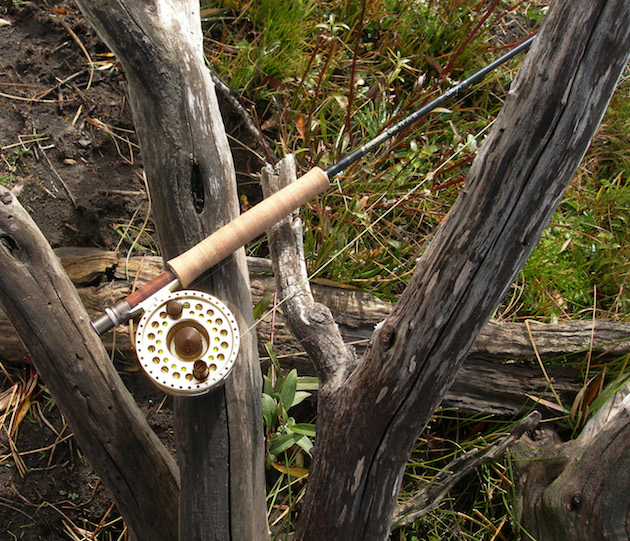
Sage makes some of the most reliable and versatile fly rods and reels on the market.
A trip such as this demands only the best, most refined tackle available. And as always, we used only Sage fly rods in a wide array of models and weights.
I have always envied career business travelers for the way they navigate an airport. They negotiate the security lines with practiced ease and weave effortlessly through the crowds to reach their gates. As for me, I fly far less frequently and balked at the thought of complicating matters by carrying a metal rod tube through three different airports.
It takes an extremely special fly rod for me to carry it cross-country and back again, but my vintage Sage RPL+ was well worth the effort. This time-tested 9-foot, 2-piece, 3-weight jewel has been in our family for well over 25 years, and I could not have imagined a better rod to fish Chama’s Poso Creek, which carves a circuitous path in a lush green valley nestled between towering mountain peaks and provides a pristine habitat for native rainbow, brown, and brook trout.
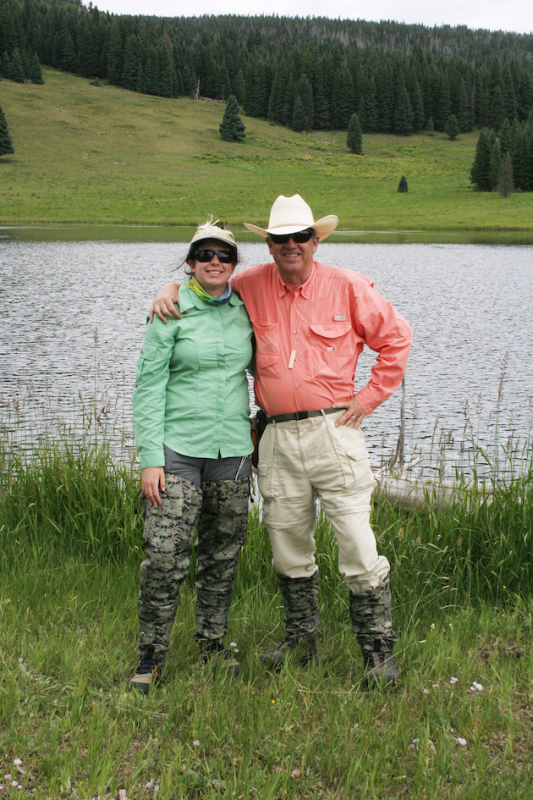
The author and her father and fellow Sporting Classics contributor, Mike Altizer.
While my dad was perfectly comfortable with his little Sage LL 6½-foot 3-weight, I found my 9-foot RPL+ to be the perfect length, weight, and action to work the mountain breezes and make accurate casts into the winding riffles. It felt like an extension of my body, whether I was making delicate casts into the narrow confines of the little creek or simply “dapping” down through the overhanging high grasses to guide the dry fly down-current and beneath dark ledges.
On the other hand, trolling from the kayaks required a heavier rod with sinking line, so I switched to my 4-piece, 9-foot, 6-weight Sage Xi3. While technically a saltwater rod, the Sage Xi3 worked beautifully for this sort of lake fishing, enabling me to feel every hit, from the nuanced nibble of a curious trout to the vicious strike of a hungry lunker. Once the fight was underway the rod’s perfectly balanced power and action allowed me to keep the trout from diving underneath the kayak and carefully guide them into the net.
Finally, our entire group raved about Sage’s flagship rod, the Sage ONE. Dad had bought the 5-weight 9-foot model for his recent trip to Patagonia, and we now found it perfect for Chama’s high country lakes and streams. The Sage ONE has lived up to Sage’s rich tradition of continually redefining fly rod technology, and we used it in Chama’s classic streams and lakes with multiple lines, tactics, and flies. Mom trolled from the Hobie kayaks with this rod, and we discovered that our dear friend and guide, Pat Carpenter, used this same Sage ONE in a 10-foot, 5-weight model while fishing these high lakes with dry flies and droppers.
For more information about the Sage ONE, please visit sageflyfish.com/fly-rods/all-water/one/.
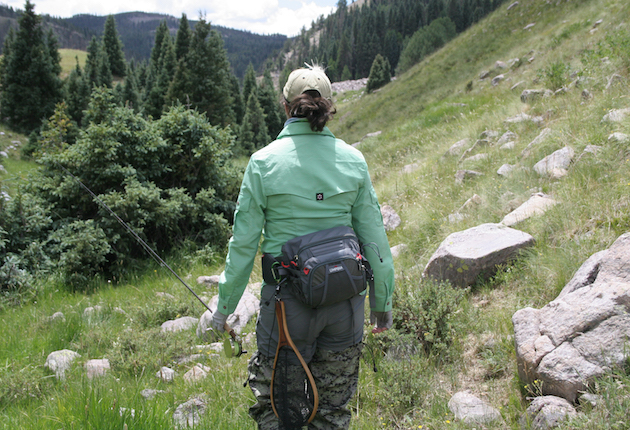
Walking from one fishing hot spot to the next in New Mexico.
In terms of gear, Hobie offered a new way to experience Chama’s high-country mountain lakes through an intimate, human-powered connection with the water while allowing the kayak to work with the angler to hook and play the fish. Our family has extensive history with Sage rods, and that history continued as we fished the lakes and streams of Chama with great success.
If You Want to Go
Northern New Mexico’s Lodge and Ranch at Chama Land & Cattle Company is one of North America’s premier fly fishing destinations. From its numerous high-country lakes to the pristine beauty of the Poso Valley and the headwaters of the legendary Brazos River, there is not a more captivating place on earth to pursue your fly fishing passions.
And all the while you will revel in Chama’s award-winning, 27,000-square-foot lodge, with its extraordinary accommodations, amenities, corporate facilities, and cuisine. Owned by the Jicarilla Apache Nation, the Lodge and Ranch at Chama is a great place to share with your spouse, your family, your friends, and your clients.
For more information, call 1-575-756-2133 or visit lodgeatchama.com.

